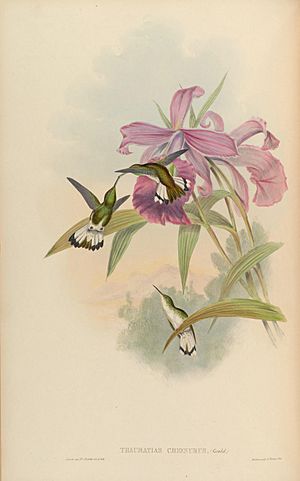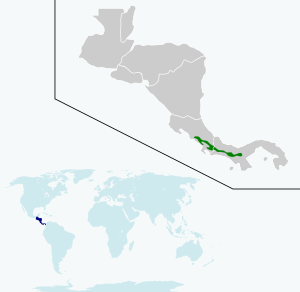White-tailed emerald facts for kids
The white-tailed emerald (scientific name: Microchera chionura) is a beautiful type of hummingbird. It belongs to a group of hummingbirds called "emeralds." You can find this tiny bird in the countries of Costa Rica and Panama.
Quick facts for kids White-tailed emerald |
|
|---|---|
 |
|
| Conservation status | |
| Scientific classification | |
 |
Contents
About the White-tailed Emerald
Scientists group living things like animals and plants into different families. This helps us understand how they are related.
The white-tailed emerald used to be in a group called Elvira. Another hummingbird, the coppery-headed emerald, was also in this group.
But in 2014, scientists did a special study. They looked at the birds' DNA. This study showed that the white-tailed emerald and the coppery-headed emerald were actually very close to another bird called the snowcap.
Because of this, the three birds were all put into a new group called Microchera. This name was chosen because it was the oldest name for one of the birds. So, the white-tailed emerald is now officially part of the Microchera group.
This hummingbird is monotypic, which means it is the only kind of white-tailed emerald. There are no different types or subspecies of it.
What Does It Look Like?
The white-tailed emerald is a small bird. It is about 7.5 to 8 centimeters (about 3 inches) long. Males weigh about 3.3 grams, and females weigh about 3.1 grams. That's about the weight of two paper clips!
Both male and female birds have a black beak. The bottom part of their beak is often a little pink.
Male White-tailed Emeralds
Adult males have shiny bronze-green feathers on their backs. These feathers turn a darker copper-bronze near their tail. The two feathers in the very middle of their tail are copper-bronze. The other three pairs of tail feathers are white with black tips.
Their throat and chest are a sparkling green. Their belly, under their tail, and the feathers under their tail are white.
Female White-tailed Emeralds
Adult females also have bronze-green feathers on their backs. The two feathers in the middle of their tail are bronze. The other three pairs of tail feathers are white with a black band near the end.
Their underparts are a dull white. Their sides have some bronze-green feathers.
Young White-tailed Emeralds
Young males look a lot like adult males. But their underparts are not as bright. They have grayish-buff edges on their feathers. Young females have grayer underparts than adult females.
Where Does It Live?
The white-tailed emerald lives in the mountains of Costa Rica and Panama. You can find it on the Pacific side of these countries. Sometimes, it is also seen on the Caribbean side of Panama.
This hummingbird likes to live in moist or humid mountain forests. It can be found at the edges of these forests or deep inside them. It also lives in forests that are growing back after being cut down. Sometimes, you can even spot them in plantations and gardens.
Inside the forest, male white-tailed emeralds often fly high up in the treetops. Females usually stay lower, in the understory (the plants growing under the main trees).
They live at elevations from about 750 to 2,000 meters (about 2,460 to 6,560 feet) above sea level. In Costa Rica, they mostly breed between 1,000 and 1,700 meters (about 3,280 and 5,580 feet).
How It Behaves
Movement
Scientists are still learning about how the white-tailed emerald moves around. In Costa Rica, some of these birds move up and down the mountains. This happens when it's not their breeding season.
Feeding Habits
The white-tailed emerald eats nectar from many different kinds of flowers. It finds these flowers both at the edge of the forest and deep inside it.
Besides nectar, it also catches small insects and spiders. It does this by "hawking." This means it waits on a perch, then quickly flies out to catch an insect in the air, and then returns to its perch.
Reproduction
The white-tailed emerald's breeding season is from June to November. During this time, male birds gather in small groups to try and attract females. These special gathering spots are called "leks."
We don't know much else about how these birds raise their young. Scientists have not yet found or described their nests.
Vocalization
The song of the white-tailed emerald is a "long, thin, scratchy twittering." It also includes buzzing or gurgling sounds.
When the bird is looking for food, it makes "soft, scratchy chipping notes." If it is chasing another bird, it makes "high-pitched, buzzy notes."
Conservation Status
The IUCN (International Union for Conservation of Nature) has looked at the white-tailed emerald. They have decided it is a species of "Least Concern." This means it is not currently in danger of disappearing.
There are at least 20,000 adult white-tailed emeralds, and their numbers seem to be stable. No immediate dangers have been found for them.
However, forests are being cut down a lot in some areas where they live. This is especially true in the lower parts of their mountain homes. Even though it's a "Least Concern" species, protecting its forest home is still important.
See also
 In Spanish: Elvira chionura para niños
In Spanish: Elvira chionura para niños


